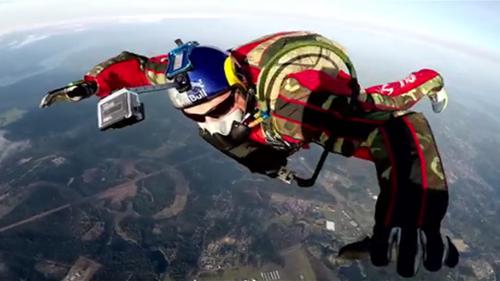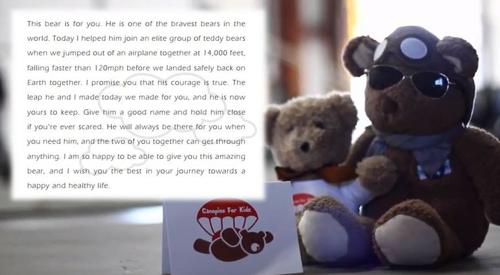Felix Baumgartner Sets Skydiving Record
All eyes were fixed on Roswell, New Mexico on Sunday, where skydiver and BASE jumper Felix Baumgartner took part in one of the largest skydiving record attempts in history. The mission, named 'Red Bull Stratos' saw Baumgartner raised to heights in excess of 120 000 feet via the use of a helium inflated balloon which was towing a 1400kg capsule. The mission, which was originally announced in 2010 had seen its fair share of ups and downs, the initial launch schedule was for 9 October 2012, but due to weather and communication issues it was postponed until the 11th of October. Things didn't go as planned on the 11th either, when despite ideal ground level winds, the winds between 700 and 800 feet were gusting too strong for a launch, which resulted in the helium balloon being blown over during the inflation process. The event was then rescheduled for 14 October, where a window in the weather conditions were seen, and the team of Red Bull Stratos were remaining positive for a launch.
Baumgartner has been a controversial figure in BASE jumping, where he has been accused of going against the general BASE ethics involved, and seeking media attention as opposed to keeping objects off the presses.
During the morning hours conditions were marginal, with the 700 ft winds remaining the area of concern. The mission was put on hold once again for several hours, but winds co-operated and at 15:25 GMT and the broadcast began to stream live. The team looked to take advantage of the weather conditions and aimed for a quick launch, which occurred successfully shortly after the broadcast began. As the balloon and capsule ascended some concern was raised when it approached the 30 000 ft mark, when Felix was being taken further east than expected due to the winds at higher altitude, though these concerns were alleviated somewhat later on after he had passed the jet stream and winds began to swing back towards the west as he ascended.
Some Quirks on the Way Up
Further concern were raised as he passed the 100 000 ft mark, when the visor of his helmet was having issues in regulating temperature. This caused enough concern for the team to consider alternative options with regards to the mission, with the option of Baumgartner descending with the capsule as opposed to performing the jump, not sure whether jumping with the error would cause a significant safety hazard. The decision was that due to the possible hard landing that could be experienced in the capsule, despite the capsule being lead down by a parachute, the best option would be for the jump to progress as planned.
On the ascent, the landmark numbers were that of Joe's 1960 record jump as well as the record for the highest ever manned balloon flight. At the height of 112 000 ft, the Redbull Stratos youtube channel was reporting over 4 500 000 users live streaming the video, with the event going viral over social networks.
The capsule began to slow down in ascent speed at around 123,000 ft as expected, but soon the ascent speed began to rise rapidly, going to a speed of 10 meters per second. This was cause for some concern and the balloon had to be vented, as Felix approached a height of 128,000 ft, 8000 ft higher than the desired exit altitude. The balloon then slowed down in the range of 127 500 ft and the checks began.
Col. Joe Kittinger at Ground Control
At the request of Felix, Joe Kittinger would be handling all the ground control communication with Felix during the mission. Joe, now 84 years of age was a career military officer and a former Colonel in the United States Air Force. Prior to this mission Kittinger held the world records for the highest skydive, fastest and the longest skydive. In the year 1960 Kittinger performed a skydive from the height of 102 000 ft, an amazing accomplishment, especially for the time. This record held strong for over 50 years, until Sunday 14 October 2012. Kittinger's flight was not without it's own set of hiccups too, during his record setting skydive, a tear in his glove caused his hand to swell up to twice the size, due to the amount of pressure at those heights.
The checks began as the balloon's ascent slowed down considerably and by the 21st check, Felix began to depressurize the cabin to 40 000 ft and confirm a suit inflation, this check was successful and moved them onto the next item, which was depressurizing the capsule to ambient pressure at a height of 128 000 feet. The world at this stage was hanging on the edge of their seats, as Felix depressurized further and the balloon began to descend. At 127 500 ft the door was opened and Felix began to move towards the front of the capsule, the earth's curve clearly visible on the cameras. The balloon ascended again a bit to a height of 128 000 ft, when his chute was confirmed as okay to jump... Then after a couple more checks - he was off!
Controlling the Spin
The exit was un-dramatic, flat and stable, exactly as planned. With so little air up there any instability on exit could lead to an uncontrollable spin or tumbling descent. After reaching speeds beyond 690mph Felix suddenly started spinning and you could almost hear the world hold its collective breath until he brought it under control what felt like too many seconds later. Maximum speeds quickly reached over 720mph, but were also quick to decelerate as the air thickened. During the freefall stage Baumgartner went on the radio saying that his visor was starting to fog up, but this was shortly before he had to open his chute, was ended up not being an issue. Felix Baumgartner had hoped to reach super sonic speeds, to gain the record for the longest freefall time and to break the speed of sound. Unfortunately for Felix, his freefall time did not exceed that of Kittinger's, but he now holds the confirmed record for the highest ever skydive, and while not yet official, his top speeds are also estimated to have set records. Given Kittinger's large role in this mission, one may say that it is only fair that his record remains at least partially intact.
The day was without a doubt one of excitement, expectation, success, but also quite possibly disappointment for some. There is no arguing that this was by far the most watched live skydiving event in history, drawing more than 7,000,000 viewers from around the world live to YouTube alone, while millions more watched the event live on television.
Our congratulations go out to Felix Baumgartner on his accomplishment, as well as to Kittinger for his work at ground control, not to mention all those involved with the Red Bull Stratos mission in one way or another.
Update: The post-jump press conference has released the official record statistics from the jump. Felix jumped from a height of 128 100 feet and had an official freefall time of 4 minutes and 20 seconds. The real surprise was the official records for the maximum velocity achieved, while original estimates were indicating that Felix reached a maximum velocity of 729 mph, this ended up being very conservative with the official finding concluding that in fact, his maximum velocity was an outstanding 833.9 mph, or 373 m/s, meaning that Baumgartner reached Mach 1.24 during his jump. This means that Felix has become the first human to go supersonic during freefall.










